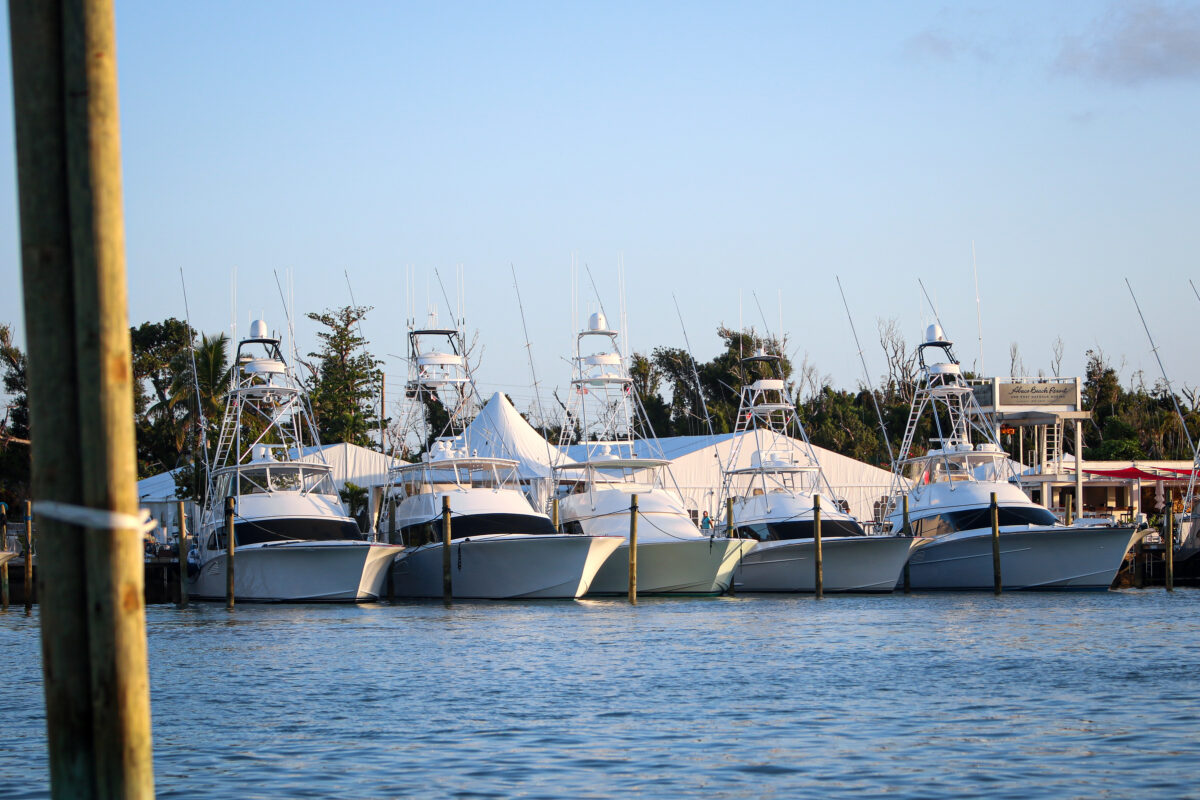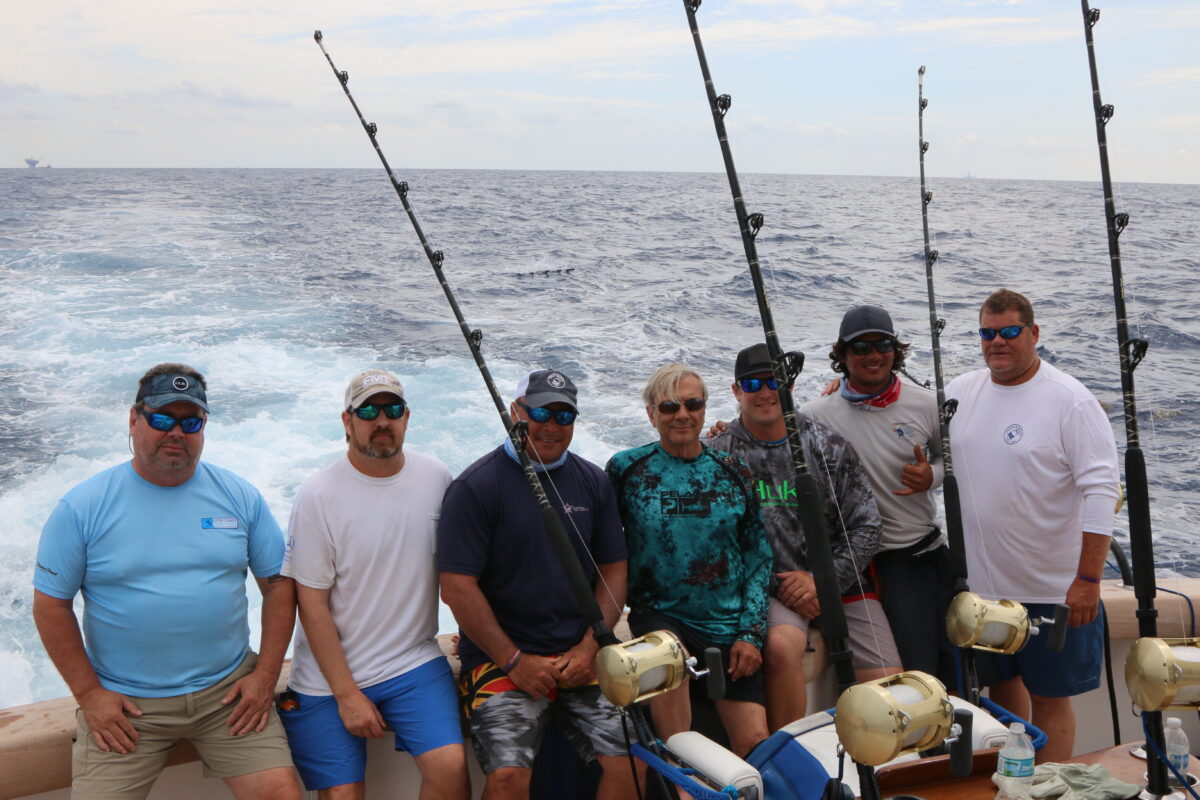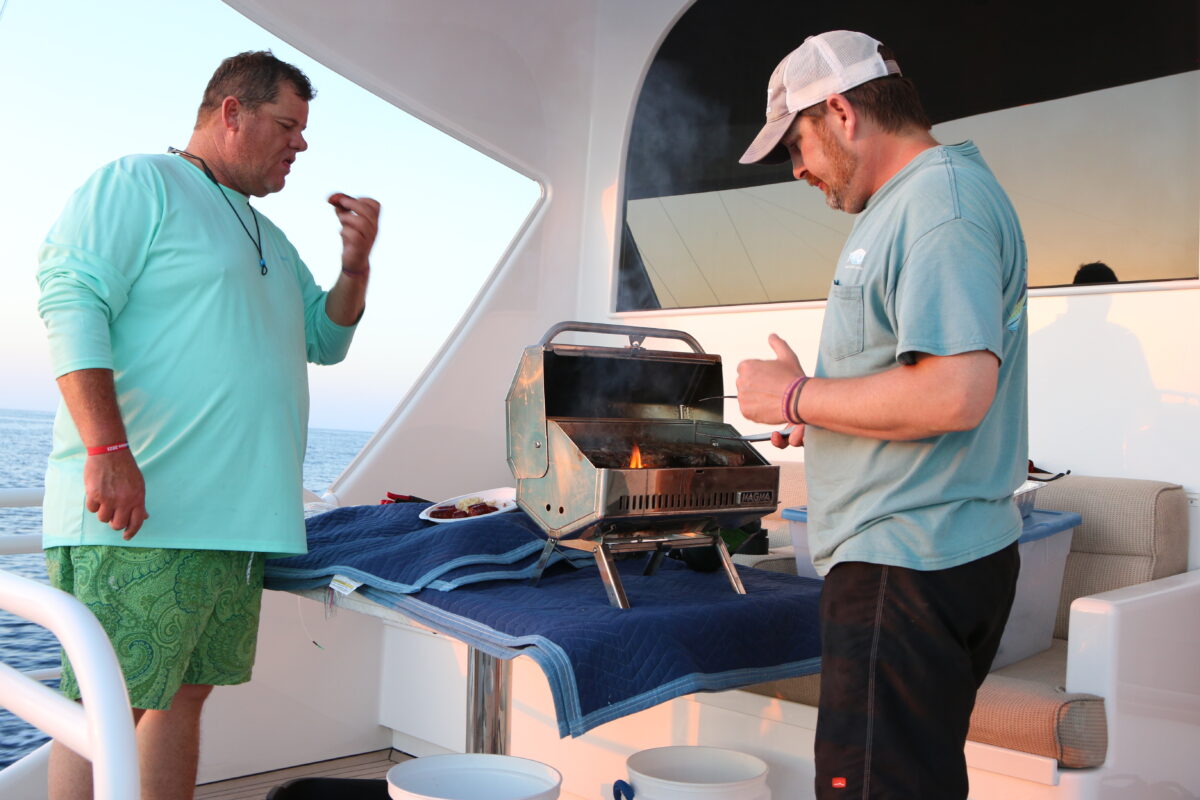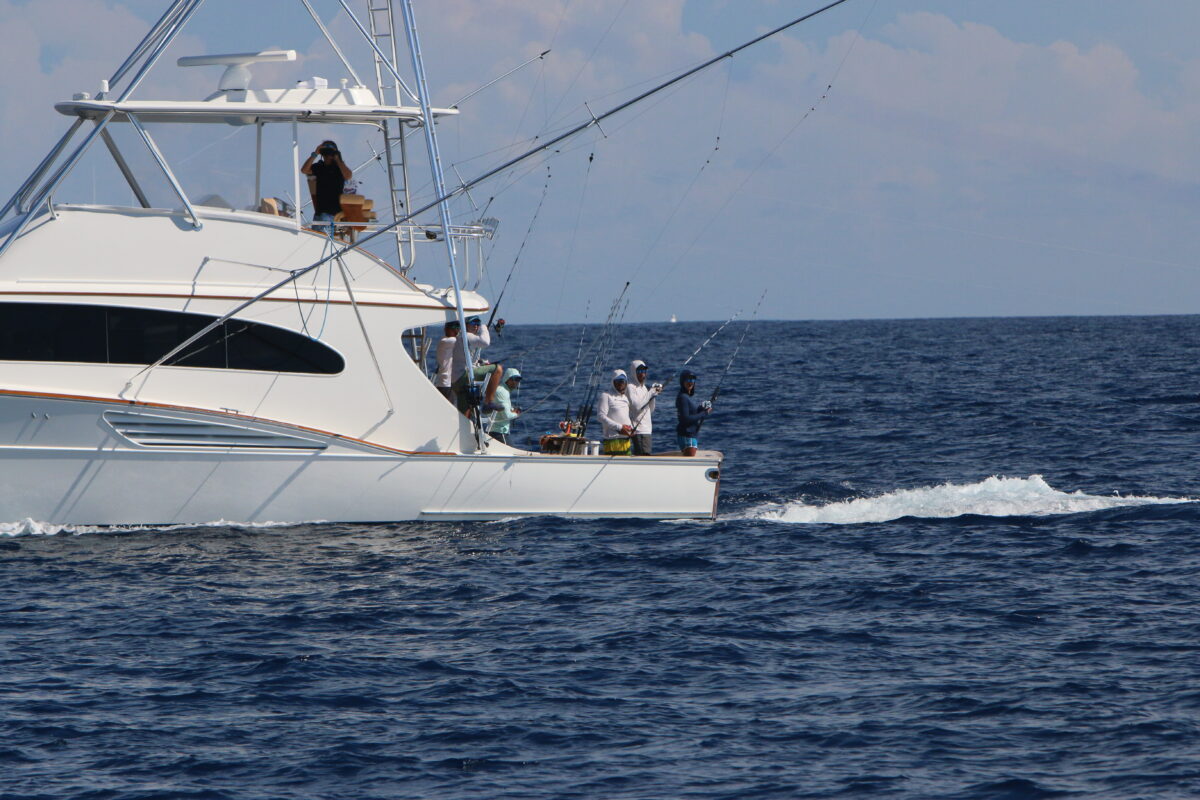When it comes to defining what it takes to be an excellent angler, there are not many better sources than Charles Perry. Perry brilliant career on the water has included granders, world records, and fishing around the world. He has seen anglers of all skill level and his presence, perspective, and graciousness in sharing knowledge made them all better. What follows is Charles Perry take on what is required to become a great angler. You might be wise to read it.
 People have asked me what the difference is between a good angler and an excellent one. There definitely is a difference! I have been fortunate enough to have fished with many very good anglers over sixty-plus years of sportfishing in many parts of the world. I have no qualms in saying that the best angler I have ever witnessed would be Mr. Stewart Campbell.
Over my 13 years of wiring fish for Stewart and Capt. Bark Garnsey, I watched Campbell steadily transform himself from being a good angler into what I consider an excellent one. While this is not an article about Stewart, per se, many of his approaches to fishing embodied the practices and commitment necessary to becoming an excellent angler.
People have asked me what the difference is between a good angler and an excellent one. There definitely is a difference! I have been fortunate enough to have fished with many very good anglers over sixty-plus years of sportfishing in many parts of the world. I have no qualms in saying that the best angler I have ever witnessed would be Mr. Stewart Campbell.
Over my 13 years of wiring fish for Stewart and Capt. Bark Garnsey, I watched Campbell steadily transform himself from being a good angler into what I consider an excellent one. While this is not an article about Stewart, per se, many of his approaches to fishing embodied the practices and commitment necessary to becoming an excellent angler.

When you have a giant blue submarine in your spread is no time to be looking down at your reel.
Knots and Drag”Good Things to Know
An excellent angler knows knots! Stewart tied his knots for all the different line classes that he used. He owned a line testing machine at his home and tested all his knots. He tied all his doubles and all his top shots. He could tie a Bimini faster by himself than most good deckhands. He even knew the page number in Ashley Book of Knots for most of the knots that he used.
In addition to tying his own knots, Stewart checked the drags on all of his reels daily. Because he fished mainly for Atlantic blue marlin world records, we usually had at least four different line classes in the rocket launcher at the same time. We fished four teasers, no hooks.
Every morning, Stewart would check the drags on each line class. From six-pound up to 20-pound (6, 8, 12, 16, 20), he would pull the drag with the rod while one of us would hold the scale. He would fight fish on all these line classes standing up.
 We used a digital scale, and he would call out what he thought the drag was. He was usually within a few tenths of being accurate, so we very seldom needed to correct him. He did this often enough that he knew how much drag he was using by the bend in the rod.
On 30- and 80-pound, he would sit in the fighting chair, and we would pull the drag from the dock. Thirty and 80-pound were the only heavy tackle he used for blue marlin. If he broke a fish off”something which rarely happened”we would check the drag immediately to know what the tension was when it broke. His ability to know where the drag was at all times was amazing.
He also changed the drag quite often during the fight. The faster the fish swam away on the first run, the more he would keep backing off on the drag. When the fish slowed or stopped, he would go back up on the drag. Ive even seen him go into free spool on light tackle when the fish would go down deep and not do anything for quite a while. That sometimes would cause the fish to make a move, which was what we wanted.
We used a digital scale, and he would call out what he thought the drag was. He was usually within a few tenths of being accurate, so we very seldom needed to correct him. He did this often enough that he knew how much drag he was using by the bend in the rod.
On 30- and 80-pound, he would sit in the fighting chair, and we would pull the drag from the dock. Thirty and 80-pound were the only heavy tackle he used for blue marlin. If he broke a fish off”something which rarely happened”we would check the drag immediately to know what the tension was when it broke. His ability to know where the drag was at all times was amazing.
He also changed the drag quite often during the fight. The faster the fish swam away on the first run, the more he would keep backing off on the drag. When the fish slowed or stopped, he would go back up on the drag. Ive even seen him go into free spool on light tackle when the fish would go down deep and not do anything for quite a while. That sometimes would cause the fish to make a move, which was what we wanted.

The Chunda”with Stewart Campbell, Capt. Bark Garnsey, Charles Perry and crew”caught many a big blue marlin.
Communication
Angling is an individual effort made by part of a team. Communication between the team players is very important. Before Stewart would make any adjustments to the drag, he would let the crew know. Capt. Bark wore a headset with a microphone with two speakers in the cockpit. He kept the rest of the team informed of things we needed to know during the fight, usually with a bit of humor thrown in. Whenever he would turn to run the fish down, there would be a crew member on each side of the boat looking forward. Whenever the fish would jump one of us (sometimes all of us) would holler, IN THE AIR. Stewart would have his fingers on the drag lever, and upon hearing this call, would immediately pull it back. A fish moves through the air faster than it does through the water and can easily break the line. As soon as the fish would settle down, he would go back up on the drag.

For Campbell, the commitment to being an excellent angler was a lifelong affair.
Know Your Equipment
I brought up the topic of what makes an excellent angler with my friend, Paul Spencer of Spencer Yachts. He made a good point about how important it is for the angler to be familiar with all the equipment that will be used. For example, if you will be using 30-pound line, then maybe secure your line to a dock piling and back off 30 yards and pull on it till it breaks. After you do this a few times, you will have a better feel for what it takes to not break a fish off. You also might practice taking the rod from the rocket launcher or the rod holder without looking at it so when picking up the rod you can keep your eye on the fish without looking down at the reel. All these little things add up to make a big difference.

This was the fish that snatched Campbell over the gunnel.
Line Management
An excellent angler also is aware of approximately how much line is off the reel at all times. We put marks on the line with a permanent marker, usually a red mark at 25 yards and another colored mark at 75 yards.
With light line, it is often difficult to tell how many yards of line are out. This is generally good to know at all times, but it especially important when you are turning to run the fish down. When the red mark came up, we all got ready for the finale”which didnt always happen as planned. While Stewart was angling, he also would let us know when the fish made a sudden move. Keeping each member of the team informed while the fight was on was very important.

Angler Positioning in the Cockpit
Where the angler is positioned in the cockpit while fighting the fish can be quite important. When Stewart was fighting a fish stand-up on light tackle, we would spin the chair around and he would lean his back against the rocket launcher. Capt. Bark would always let us know when he was coming around with the boat to chase the fish. Stewart would then move to the corner to give Bark a better angle to chase the fish down. If he was fighting the fish from the chair, he would just take the rod out of the gimble and move to the corner until Bark came back around on the fish. He always tried to make it as easy as possible for all the team members. Given the amount of movement that can be required during the fight, good deck shoes are very important as well. We all had a pair with nonslip soles that never left the boat. Street use quickly takes away the good grip. Stewart didnt always wear them but would put them on as soon as he got a fish hooked. Quick safe movement on a wet deck is very important to successful and safe fishing.

The results of Campbell dedication are still on display in the record books
Physical Conditioning
Another thing Stewart did consistently was to stay in topnotch physical condition. Conditioning is a crucial component to being an excellent angler. A couple of times a day while we were watching the spread, we would take turns doing pullups on the bar supporting the hardtop. If you liked winning, it was best not to challenge Stewart in a pull-up competition”even when he was in his sixties.

Commitment to Being Excellent
Another facet of excellent angling, I believe, is commitment. When Stewart asked Bark to be his captain many years ago, Bark first question was, What exactly do you want to do? Stewart said he wanted to be the best angler he could possibly be. Stewart Campbell was committed to constantly improving as an angler. Immediately after releasing a fish, he would ask me what he did wrong or what he could have done better. He would then ask the other crew member the same question before climbing the tower to ask the same of Capt. Bark. Not only would he get each of our individual opinions right at the time of the fight, but quite often we would all discuss the day fish over our evening meal. He didnt always make the changes that we might suggest, but he always wanted to hear our opinions. Sometimes it would take us a few days to convince him that some small change or a slightly new technique was really his idea. By knowing he was going to ask us questions after the fight, we would pay closer attention to his angling style and try to decide if there needed to be changes made. Each fish was truly a learning process. [vimeo 9886244 w=640 h=480] Man Overboard | Marlin Fishing Featuring Stewart Campbell from Guy Harvey Sportswear on Vimeo. His commitment to improving his angling never faltered through the years. He never stopped learning. It not that he didnt make mistakes, but when he did, he would be the first to admit to them. A good example of that was when he was snatched over the stern of the boat in Madeira by a possible blue marlin world record on 30-pound line. He disappeared under the water for what seemed like forever (even though it was just a few seconds). The first words out of his mouth as soon as his head popped up were, I know what I did wrong! The cable leader wrapped around the rod tip and the fish took off, snatching him and the rod overboard as the fish jumped away from the boat. In Stewart mind, his mistake had been failing to reel the swivel all the way to the rod tip”doing so would have prevented the slack that allowed the cable to wrap around the rod. He had seen his mistake before he went over the stern and wanted to immediately take responsibility. After getting back from the hospital late that night and having his hand in a cast, we suggested maybe taking a day off the next day to rest a bit. He said, No way, they are on the bite. We went fishing the next day! His commitment to be the best angler he could be was truly unsurpassed. If the weather was rough, he would feel bad or be seasick. This, in fact, was the reason he named his boat Chunda, an Australian slang word for throwing up. Feeling bad never held him back from his fishing.

The Chunda”with Stewart Campbell, Capt. Bark Garnsey, Charles Perry and crew”caught many a big blue marlin.
Results of Campbell Commitment: 73 Bluefin in a Day
In the winter of 1994, the bluefin tuna showed up heavy in Hatteras, North Carolina. We called Stewart in Texas and suggested that he could get plenty of angling practice with heavy tackle if he would like. Two days later he was there. On a 40 G & S named the Raptor, with Capt. Peter B. Wright driving, Capt. Gary Stuve and myself wiring, John Rafter keeping the bluefin behind the boat all day with free menhaden, and Charlie (Splittail) Hayden filming, Stewart caught 73 bluefin in eleven and a half hours. That catching a bluefin tuna every nine and a half minutes! The tuna averaged from three-hundred to five-hundred pounds. Obviously, he was not just a light tackle angler! Just to emphasize his conditioning at that time, the day after he caught 73 bluefin Campbell turned 65. He was using a Cal Sheets (the Reel Magician) converted Penn 130 that could get 95 pounds of drag and still have free spool. He was using a top shot of 200-pound mono. He was striking these fish with 65 plus pounds of drag and then going straight to sunset”applying full drag without ever letting the rod touch the covering board. It was truly an impressive bit of heavy tackle angling! Unfortunately, Stewart Campbell passed away over 12 years ago. As of today, he still has four spearfish world records in the books as well as four blue marlin world records on different line classes. That to me, certainly qualifies Mr. Stewart Campbell as an excellent angler. Do you have any comments or questions for us? We’d love to hear from you.













